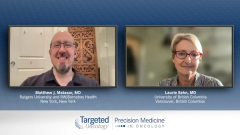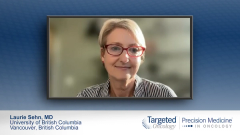
Novel Targeted Agents in Multiply Relapsed Follicular Lymphoma
Switching to the paradigm of multiply relapsed follicular lymphoma, expert participants discuss the rationale behind and use of PI3k- and EZH2- targeted therapies.
Episodes in this series

Transcript:
Matthew J. Matasar, MD: I’d love to hear your take on the emerging and broadening armamentarium for patients with multiple relapsed FL [follicular lymphoma] and how you looked at the currently available agents and any agents that are yet to come.
Laurie Sehn, MD: I think it’s an exciting time. We are starting to see more and more options become available. It also makes it a challenging time because it means that we’ve got more to think about in terms of how to sequence some of these novel agents that are showing benefit for patients with relapsed/refractory follicular lymphoma. PI3-kinase [PI3k] inhibitors have been around for a while now, mainly approved in the third-line setting and beyond. They’ve shown what I would describe as modest activity for relapsed/refractory follicular lymphoma, and therefore remain an option, but what we’ve seen is that the concerns for toxicities have kind of stunted their use across the board. We’ve seen several of them actually come off the market for follicular lymphoma this year because of the [competing drug market], and probably, risk-benefit ratio no longer favoring those agents. We know that copanlisib, for example, is a PI3-kinase inhibitor that is still available, but I do think that that is a drug that, in my mind, has somewhat modest activity and also a difficult schedule for patients. It’s quite frequent treatment, it’s intravenous treatment, it is not a drug that I would routinely use in my own clinic.
Matthew J. Matasar, MD: Copanlisib is an interesting drug because it doesn’t have the toxicities that have plagued the oral PI3k inhibitors. It’s low rates of hepatitis, enteritis, and pneumonitis. For patients that live close to a center and don’t mind a weekly schedule, it’s a nice agent to offer, particularly if they’re more frail and may not tolerate more intensive treatment approaches. But the schedule really is limiting, and it would be nice to see some data with the agent around intermittent treatment. Either spacing out the therapy or giving treatment holidays to avoid this [3 weeks on 3 weeks off dosing] until progression or intolerance, which can be so challenging for patients.
Laurie Sehn, MD: I fully agree. I have to say that’s been a problem with PI3-kinase inhibitor development across the board. I don’t feel that, as a class of agents, we need to throw them out. I think we need to better understand how they could be used in a safer fashion. Even the oral drugs that are no longer available or recommended, if we can go back to the drawing board and think about how we might use them at a different dose level, maybe in a combination where they offer synergy but don’t need to be used indefinitely. I think we need to go back to square one for some of those drugs.
Matthew J. Matasar, MD: Partially this is why I’m excited about zandelisib as a future therapy. Knowing that we have this agent that you get for 2 months in an induction format before you start seeing the emergence of the immune-related adverse events from the tonic T-reg [regulatory T-cell] inhibition, and then you go to a 1-week on 3-weeks off format, showing that you can give that drug in a sustained fashion in this way, without sacrificing disease control, and without incurring the toxicity profile of daily oral administration of PI3Ks. I’m hopeful that future data will affirm the early findings and lead to this becoming a relevant option for patients.
Other agents that have become available, beyond the space of PI3Ks, include the EZH2 inhibitor tazemetostat, which is a definitely unique drug in this disease. I’d love to hear your perspective on how that’s currently being used and how it might be u
sed in the future.
Laurie Sehn, MD: Yeah, I think that’s a fascinating drug, because it really is one of the first drugs that we’ve had that is designed to manipulate what we understand to be part of the relevant biology of follicular lymphoma, and that is epigenetic dysregulation. So the EZH2 inhibitors target something that is mutated in only about 20% of patients with follicular lymphoma but is probably clinically relevant in the majority. The intriguing thing about this drug is that it’s easy to administer, and that it’s oral. The other intriguing thing is that the toxicity profile is really low. So it’s a well-tolerated oral drug that does have activity in follicular lymphoma. Although, in the pivotal trial that earned its approval, what we saw is that it was more effective in patients who had EZH2 mutations than in wild-type patients. That, unfortunately, is the minority of patients, probably about 15%-20% only. But in that subgroup of patients with known EZH2 mutations, it can be a very effective option. The response rates are fairly high and we’ve seen durable benefits reported in that patient subset. It’s probably not the drug I would rush to give in a patient who had wild-type EZH2 by testing, but we know that even some of those patients can benefit. I think it’s all a matter of, at that point, what are the other options available to the patient and sort of balancing out that risk-benefit ratio.
Matthew J. Matasar, MD: It is interesting that even the wild-type patients that respond, it’s a lower overall response rate, clearly, but the patients that respond seem to enjoy a durability of response that’s comparable, or maybe even a little better, to that experienced by the patients who harbor EZH2 mutations. I think this leads me to believe that we don’t really understand exactly what this drug is doing. We don’t have the best biomarkers for predicting response.The flip side of that is the tolerability.
Laurie Sehn, MD: Absolutely, I fully agree with you. There’s probably something that we’re not currently measuring to allow us to identify the patients who will benefit the most or the longest. But, at least at this point in time, given that discrepancy in response rates, I’d probably be more apt to use it in a patient that I know had mutated EZH2 than [one who did] not. I think your point is really well-taken, that patients with wild type EZH2 who benefit do seem to have equally durable benefits, so clearly it’s probably working in a way that we don’t fully understand.
Matthew J. Matasar, MD: In my practice, tazemetostat is an attractive option for older and frailer patients. These are patients that are not always well-captured in clinical trials, and certainly not always cared for in the context of academic medical centers, but this is a disease that is more common as we age and certainly the burden of FL in older, frailer populations is under-recognized. A drug with a toxicity profile that’s as favorable as that of tazemetostat is an appropriate option for such patients, even in the absence of a mutation, or in the absence of knowing the mutational status.
Laurie Sehn, MD: Absolutely. As you state, this is often a disease of elderly patients, and patients with other comorbidities, and many of the treatments that we have really might be inappropriate for certain patients in our clinic. I think this is where patient preferences come in as well. Beyond suitability, we know that we’ve got patients who have different preferences in terms of the types of treatments that they want. So with this as an option, I think it does become an important discussion with a patient, weighing in expectations of benefit vs the positive aspects of convenience, in that it’s oral, and of course the low toxicity profile. It’s certainly an important addition, I think, to options that patients will need to consider.
Transcript edited for clarity.










































